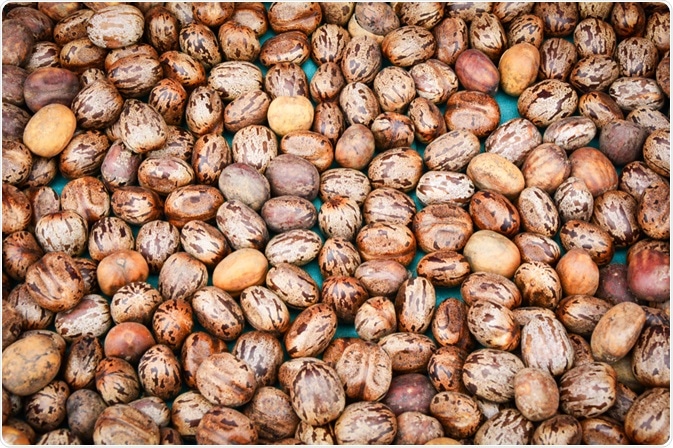Ricin is one of the most toxic substances known to science with an LD50 between 3 and 30 µg/kg in humans. Potentially lethal when inhaled, ingested, or injected, death can occur within 36 to 72 hours upon exposure. Ricin works by preventing the body’s cells from producing essential proteins, which leads to cellular death. There is no known antidote for ricin poisoning.
 Poring Studio | Shutterstock
Poring Studio | Shutterstock
Occurring in the kernel of the castor bean, a species indigenous to East Africa which is used to produce castor oil, ricin can be produced from the “mash”, a by-product of castor oil processing. Stable under normal conditions, ricin can be inactivated by heat over 176 degrees Fahrenheit (80 degrees centigrade). It can be processed into powder, pellet form, mist, or be dissolved in weak acid or water.
Unless the castor bean is chewed and ingested, unintentional ricin poisoning is unlikely, and ricin must be deliberately produced to be able to be used as a poison.
Effects of different routes of ricin poisoning on the body
Depending on the route of exposure and the dose administered, ricin poisoning can have different effects on the body, with differing levels of severity and potential lethality. Initial symptoms can appear after 4-8 hours following exposure, and in some cases up to 24 hours.
Inhalation
Inhalation of significant amounts of ricin leads to respiratory distress, fever, nausea and chest tightness within hours of exposure. Pulmonary edema (the build up of fluid in the lungs) can follow. Eventually, this can lead to respiratory failure which can be fatal.
Ingestion
Ingestion of ricin can lead to vomiting and diarrhea, which potentially could be bloody. This can result in severe dehydration and low blood pressure. Seizures and passing blood in the urine can also be symptoms, and in the most severe cases organ failure (kidney, liver, spleen) can lead to the person’s death.
Skin and eye contact
Exposure to the skin and eyes with ricin can cause redness and pain. Whilst it is unlikely that absorption of ricin can occur through normal skin, it occurs that if ricin is on one's hand and food is consumed afterward that the ricin is thereby ingested.
Ricin is of concern to governments and scientists worldwide because of its potential weaponization. Due to its lethality, it has been used offensively, including for the assassination of Georgi Markov, a Bulgarian writer, and dissident in 1978. There have also been reports of its use in Iraq as a chemical weapon. The US Army investigated its application in the 1940s.
Considering the ease with which ricin can be produced, and its potential use as a weapon, studies are ongoing into how to detect and treat ricin intoxication in the event of it being used in these ways. One such area of research is that of metabolomic profiling.
Metabolomic profiling of ricin
Metabolomic profiling is the measurement of multiple small molecule metabolites in biological specimens. This includes tissues, bodily fluids such as blood and urine, and breath exhalate.
In a study by Pingping Guo et al. in 2014, an NMR-based metabolomics approach was used to investigate ricin toxicity. They complemented this with clinical chemistry and histopathological inspection.
The study highlighted several metabolic disturbances caused by intoxication with crude ricin isolated from castor beans, which lead to decreased nutrient uptake, lung and kidney impairment as well as thymus and spleen dysfunction in rats. Long-term crude ricin intoxication produced energy, nitrogen and amino acid metabolism perturbations, as well as evoking oxidation stress.
Guo et al. furthermore found potential biomarkers which could be useful for diagnostic studies of the toxicity of ricin that could explain why ricin has such a high toxicity.
Riccardo V. D’Elia et al. in 2019 studied the effects of ricin intoxication on Sprague-Dawley rats, and attempted to study metabolic changes over time. In the study, they administered ricin intravenously into the rats and collected blood samples from the animals for up to 48 hours after exposure. They analyzed blood plasma isolated from the samples, applying HILIC and C18 reversed-phase UHPLC–MS assays and followed these with multivariate and univariate analysis.
They found that a total of 37 metabolites were altered significantly by ricin intoxication (compared to control groups), with the most significant ones being the triglyceride, bile acid, and arginine/proline metabolic pathways.
The results of these studies helped to demonstrate that metabolites may be useful as a tool to detect and diagnose ricin exposure.
The potential of metabolomic profiling to assist health professionals to provide treatment at a stage early enough after exposure to increase the chance of survival is promising. Until an antidote is found for ricin poisoning, the only effective way to help those poisoned survive is to provide treatment and therapy that counteract symptoms to the best extent possible.
Further Reading